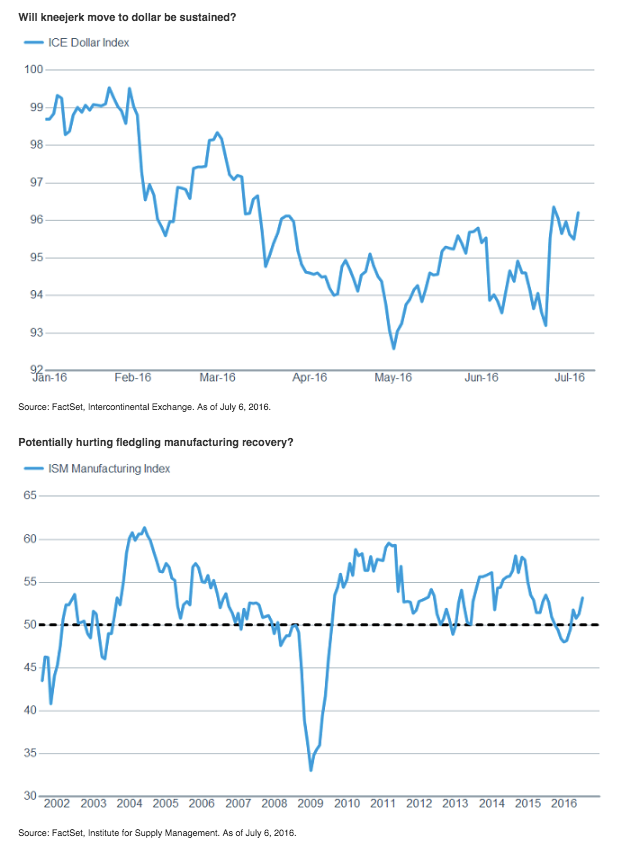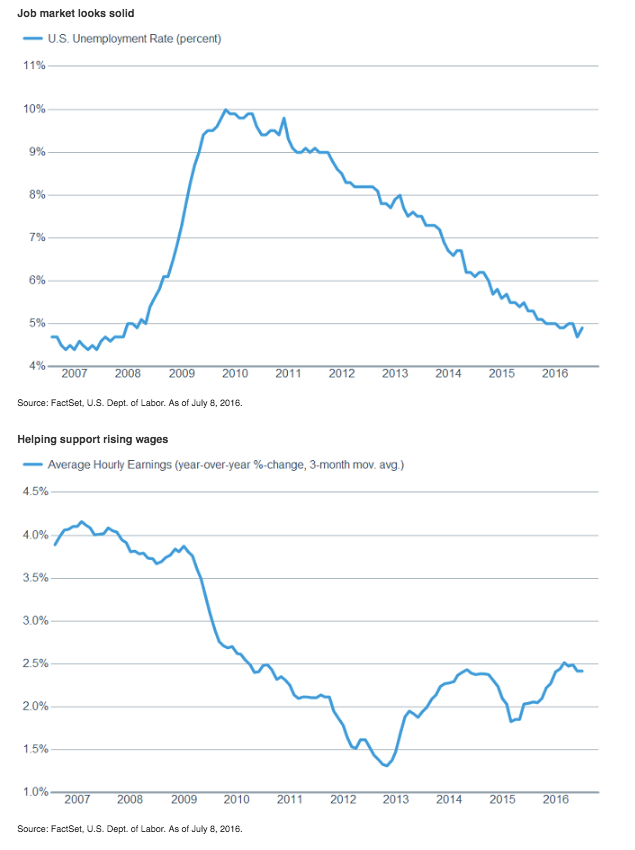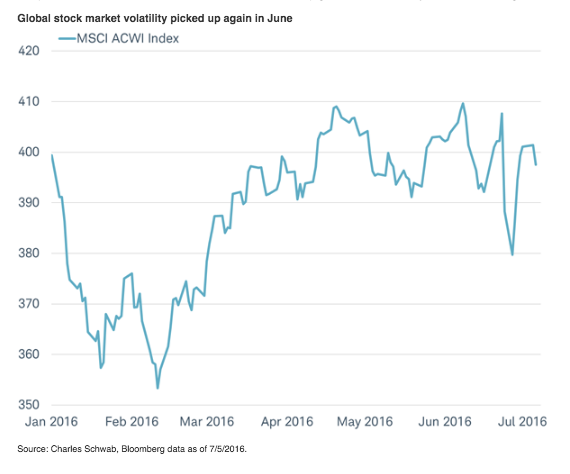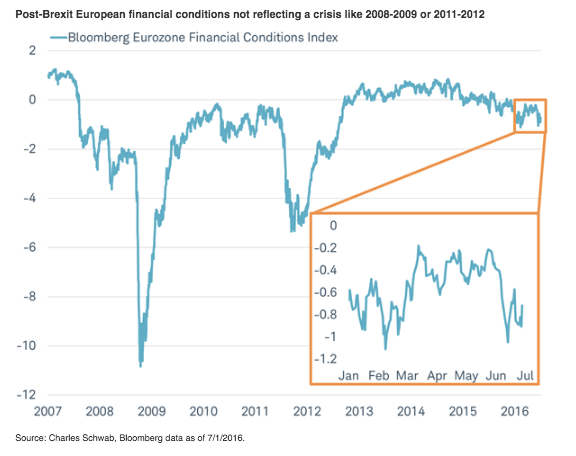Key Points
- Stock markets have recovered much of the initial loss following the U.K. (“Brexit”) vote. Attention will likely start to turn more toward economic data and the second quarter earnings reporting season, which is expected to show some improvement from a weak first quarter.
- The U.S. economy appears to be showing modest growth, and we believe for now that any hit from the British turmoil is likely to be minimal. Market expectations for a Fed hike plummeted following the vote, but with financial markets stabilizing and a solid U.S. economy, those expectations may have gone too far.
- Meanwhile, Brexit and its aftermath is likely to increase uncertainty and volatility for some time. Despite this uncertainty, we remind investors that an allocation to international investments may help to mitigate portfolio volatility.
Focus returning?
For the past couple of weeks the financial markets have been dominated by the results of a vote from a country that represents roughly 4% of world gross domestic product (GDP) according to the World Bank, and roughly 0.9% of the world population according to Trading Economics. It’s certainly not insignificant but does put some things in context. Financial markets, after a violent reaction to the shock of the vote for the U.K. to exit the European Union (EU), are putting a little context around Brexit’s aftermath as financial instruments have rebounded and shown stability in recent days. Uncertainty regarding economic growth in the U.K. and the rest of Europe will likely be with us for the foreseeable future, adding another reason for volatility to remain elevated, but that doesn’t mean investors should hide in a corner until things become more certain.
The impact on the U.S. economy from Brexit/EU-related uncertainty is likely to be via the confidence channels—both consumer and business. Although consumer confidence here in the United States has been slightly dented, we see continued supports for consumer spending, including low interest rates, higher wages, better housing data, and a healthy employment picture. From a stock market perspective we continue to hold a neutral view on U.S. equities and suggest investors use volatility to rebalance around longer-term strategic allocations. Volatility will continue to elevated but at this point we believe the U.S. economy should continue to show modest growth, helping to support similarly modest gains for equities.
U.S. economy ok, but will corporate earnings improve?
Will the uncertainty in Europe push companies to hold off on capital investments or hiring? Will the potentially stronger U.S. dollar have a negative impact on the fledgling recovery in the U.S. manufacturing sector? We’ll start to get an initial view on those questions in the next few weeks as second quarter earnings season ramps up. The results are expected to show some improvement from a weak first quarter, but those announcements may be taken with a grain of salt because they occurred “pre-Brexit.” More interesting will be any commentary we get from companies about plans that may have changed as a result of Brexit and what impact companies believe it may have in the United States.
As mentioned, manufacturing—representing about 12% of the U.S. economy—may be the most vulnerable. Hope had increased that the manufacturing recession was ending, illustrated by the Institute of Supply Managements (ISM) Manufacturing Index rising to 53.2 in June (well above expectations), from 51.3 in May. Manufacturing can be impacted negatively by a stronger dollar—possibly boosted by flight-to-safety flows—as it dents exports to other nations. Time will tell if that flight to safety we saw following the vote is extended, but for now it remains a threat to an already fragile sector of the U.S. economy.
Will kneejerk move to dollar be sustained?

Positively, the much larger (88%) U.S. services sector continues to look solid as the ISM Non-Manufacturing Index rose to a strong 56.5 from 52.9, while the new orders component rose to a robust 59.9. Additionally, the U.S. consumer is in decent shape, with personal spending rising 0.4% in May on a month-over-month basis, after rising a robust 1.1% in April. These trends are likely to continue, supported by solid job growth and rising wages. After a disappointing May labor report, which was revised even lower, the June report showed a rebound by adding a solid 287,000 jobs, while the unemployment rate actually rose to 4.9% from 4.7% as the participation rate ticked slightly higher.
Additionally, average hourly earnings (AHE) showed continued firming of wages, rising 2.6% year-over-year. One additional note, an alternate measure of wage growth—notably the Atlanta Fed’s Wage Tracker, which eliminates the mix-shift problems embedded in AHE—has shown wage growth about a full percentage point higher than AHE.
Job market looks solid

Fed reversal and conventions ahead
Healthy job growth and the possible support to inflation from higher wages lead us to wonder if market expectations around Fed policy may have gone too far. The futures market indicates roughly no chance of a hike for the balance of the year; while rate cut expectations have come back in play. While we agree that the July Federal Open Market Committee (FOMC) meeting is likely off the table for a move on rates, we aren’t dismissing the possibility of a hike later in the year. A lot can happen in a few months and if financial markets stabilize, the job market remains healthy, and inflation pressures rise the Fed could look to move toward a more “normal” rate, while also giving it some room to act if/when the U.S. economy begins showing recession risks.
The political “fun” returns to the United States toward the latter half of July, with both major parties holding their nominating conventions—two of the more interesting in quite some time. Volatility related to the election could accelerate into the debate season as we all watch the two least-popular candidates in U.S. election history face off on policy (and personality).
Usually largely ignored by markets, the populist trend in the electorate is fueling more discussion and debate about global trade, currencies (and intervention), income divisions, and regulations; which could add to the volatility of markets as we ramp up the rhetoric to an even higher degree.
Global aftershocks
Global markets continue to focus on the U.K.. Following the Brexit vote on June 23, global stocks saw a sharp 7% two-day decline followed by a rebound which was nearly as dramatic. There are more questions than answers with regard to Europe’s economic and political outlook, which could lead to aftershocks and keep global market volatility elevated in coming months.

International markets also steadied after the initial Brexit vote shock, as the U.K.’s standing in the EU doesn’t change right away, and the financial system hasn’t shown the level of stress seen in past crises. In fact, financial conditions—a key real-time indicator of the risk of a global recession—showed only a slight deterioration in June. The Bloomberg Eurozone Financial Conditions Index—which quickly signaled oncoming recessions and bear markets in both the financial crisis of 2008-2009 and debt crisis of 2011-2012—is not showing anywhere near the sharp deterioration seen in those periods, as you can see in the chart below.
Post-Brexit European financial conditions not reflecting a crisis like 2008-2009 or 2011-2012

The Bloomberg Eurozone Financial Conditions Index tracks the overall level of financial stress in Euro area money, bond, and equity markets to help assess the availability and cost of credit. A positive value indicates accommodative financial conditions, while a negative value indicates tighter financial conditions relative to pre-crisis norms.
We are also watching other real-time indicators of potential contagion and crises stemming from Brexit, including:
- Currency movements that gauge investor risk aversion (the yen, the pound),
- Changes in European countries’ yield curves which often signal oncoming recessions,
- Eurozone inflation expectations,
- How economic data compares to expectations as measured by the Citigroup Economic Surprise Index for the Eurozone.
Market volatility is likely to remain elevated in the coming months due to economic and political uncertainties. The first indications of the Brexit economic impact will be in the July data, released beginning in late July and through August. It will not be surprising to see some deterioration in initial economic releases, although it may take several months before the extent and duration of the impact is more certain.
Outside of U.K. politics, the Italian constitutional reform referendum in October, where Prime Minister Matteo Renzi could step down if he is unsuccessful, is the next political risk ahead of U.S. elections.
In the meantime, nothing is likely to happen quickly. There are a series of steps before we can fully assess the political path forward in the U.K., whether Scotland will have another referendum on U.K. membership, and the future of Ireland’s borders. Presently, the path seems to start with the U.K. selecting a new Prime Minister in September 2016; then Parliament must vote and inform the EU of the intention to leave per Article 50 of the Lisbon Treaty probably no earlier than the fourth quarter of 2016; then negotiations may begin in earnest in 2017 and could last through late 2018, or longer if extended. Until the negotiations are complete, there are no material mandated changes in the way companies do business in Europe. What we do expect is a long drawn out negotiation process as the most likely outcome. This may mean either lingering uncertainty weighs on economic activity or that it mostly stays in the background until material developments take place over the course of the coming years.
International allocations as part of a diversified portfolio can help minimize the impact of global shocks. Despite the swings in markets over Brexit, the performance of global stocks, measured by the MSCI All Country World Index (ACWI) and the S&P 500 Index differed by less than a percentage point for the month of June. Emerging market (EM) stocks actually posted gains for the month of June, outperforming the S&P 500 by over three percentage points. Even more importantly, global diversification has paid off historically over the long-term, when it was needed most. The worst 10-year period for the stock markets over the past 50 years was from February 1999 to February of 2009—a period that included both the tech and housing bubble aftermath. During that period, the U.S. S&P 500 Index fell about 40% while international stocks (MSCI EAFE Index) fell only about 10%. That’s a big difference that favors maintaining global portfolio exposure over the long-term even when times are difficult.
So what?
With Brexit uncertainty likely to remain for the foreseeable future, investors should be prepared for increased volatility, but take opportunities to rebalance around longer-term strategic allocations. At this point, we don’t see a major U.S. economic impact from Brexit, and we remain neutral on U.S. and global equities, expecting a modest upward trend with bumps along the way.